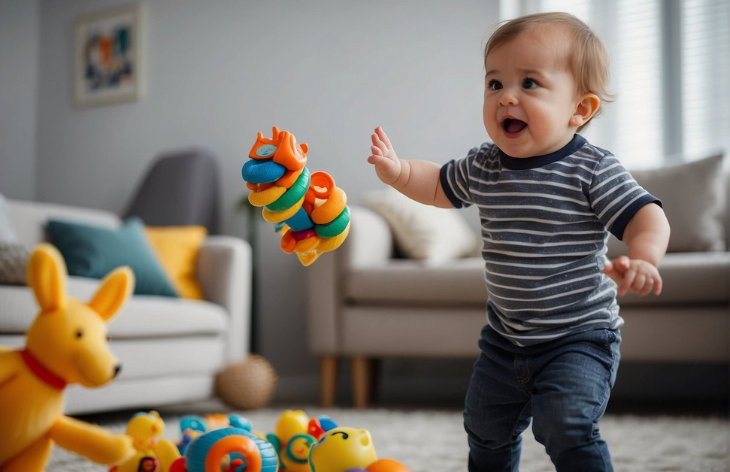When your toddler acts out as soon as dad comes home, it can be a puzzling and stressful experience.
It may seem abrupt, the shriek or the pout signaling trouble at the transition. Could there be underlying reasons why a toddler might behave differently with one parent?
Why is your little one unsettled at such times, and what can you do to ease the homecoming ripples?
Key Takeaways
- Toddlers may display challenging behaviors as a response to parental changes.
- Consistent routines and understanding parental strategies can mitigate these outbursts.
- Seeking guidance may be necessary when typical approaches don’t resolve the issues.
Shannon’s Take
Understanding Toddler Behavior When Dad Comes Home

When your child acts out as dad gets home, it’s essential to identify underlying causes, understand family dynamics, and recognize behavioral patterns. This approach ensures a comprehensive strategy to address these emotional outbursts and helps them manage their emotions.
Identifying the Causes of A Toddler That Misbehaves
Outbursts can be symptomatic of multiple factors. Your child might be seeking attention or responding to a significant change in environment, such as transitioning from one caregiver to another.
It’s crucial to consider what has changed in your baby’s life that could be prompting these behaviors.
The Role of Family Dynamics
Family dynamics play a significant role in how your child might act out. Children are sensitive to relational patterns within the family.
If there’s tension between family members or inconsistent parenting styles, your child may often act on their struggle through sudden outbursts when dad arrives home.
Behavioral Patterns and Triggers
Observing when and how your child’s behavioral shifts occur can provide critical insight. Look for patterns: Try to figure out if they act out immediately after dad’s arrival, or is there a delay? Are there specific days or situations that trigger a reaction?
By understanding these patterns, you’ll be better equipped to manage and mitigate challenging behaviors. Analyzing the emotional undercurrents of your child’s actions can lead to more targeted and effective interventions.
Parental Responses and Strategies

When your toddler misbehaves as dad walks through the door, it’s crucial to approach the situation with a well-conceived parenting plan, clear communication, and safe intervention methods. These strategies aim to alleviate the struggle and create a harmonious environment for many families.
Establishing a Consistent Parenting Plan
Crafting a plan that both you and your partner agree on can mitigate confusion and set clear expectations for your toddler.
Uniformity in parental styles acts as a stable framework for your child’s behavior. A solid plan should cover daily routines, rules, and the division of responsibilities between parents.
Consistency is key; your toddler needs to understand that the same rules apply regardless of which parent is present.
Key Elements of a Parental Plan:
- Daily schedules (meals, playtime, bedtime)
- Behavioral guidelines (what is acceptable and what isn’t)
- Parental roles (who handles discipline, who does bedtime)
Effective Communication with Your Toddler
Open, empathetic dialogue with your child helps to identify the reasons behind their behavior.
Maintain eye contact and use simple language to ensure they understand.
When talking with your toddler, it is important to listen actively and validate their feelings to help them feel safe.
This lets them know that they’re heard and understood, which can help to diffuse tension and model the kind of communication you expect in return.
Communication Techniques:
- Active Listening: Nod your head and repeat back what you’ve heard to show understanding and create a positive interaction.
- Validation: Acknowledge your baby’s feelings with statements like, “I see that you’re upset.”
Safety and Calm Intervention Techniques
When your child acts out when their dad walks in the door, it’s imperative to prioritize safety and maintain a calm demeanor.
Gently remove your child from potentially harmful situations and guide them toward a quiet space where they can calm down.
Use soothing tones and reassurances to convey safety and control over the situation.
If there are recurring episodes when your child misbehaves, note the triggers and work on preventive strategies to solve future outbursts.
Intervention Methods:
- Immediate: Calmly remove your child from the situation to prevent harm.
- Preventive: Identify triggers in your child’s life and work to avoid these scenarios.
When External Help Is Needed When Your Toddler Acts Out

Sometimes a child’s behavior may signal deeper issues that require intervention beyond what you can provide at home. If your child’s reactions to Dad coming home might feel intense, persistent, and disruptive, it may be time to consult professional guidance or understanding when to involve authorities in extreme cases.
Considering Professional Guidance to Mitigate the Behavior
If you find that your child consistently acts out when daddy comes home and typical parenting strategies do not seem to work, seeking help from a mental health professional could be beneficial.
Mental health experts specialize in understanding complex behaviors and can offer strategies tailored to your family’s needs. They can address potential underlying issues, such as separation anxiety or stress, and provide you with tools to improve family dynamics and your child’s well-being.
Role of Authorities in Extreme Cases
In situations where a child’s behavior may suggest something more abusive or dangerous is happening, or if you feel overwhelmed and unable to ensure safety, it may be necessary to get the police involved or contact the juvenile justice system.
This is a critical step in extreme cases where you may be afraid that there’s a risk of harm. Authorities can assess the situation and provide the appropriate interventions to protect your child and the family unit.
Ensuring Long-Term Well-Being and Development
Addressing the well-being of your child and steering them away from potentially destructive paths is really hard but it involves creating a foundation that secures their future. This means as a parent, you’re responsible for establishing a loving environment that not only deals with current misbehaviors but also promotes long-term recovery and development.
Fostering a Supportive Home Environment
Your home should be a haven that consistently provides support and understanding. Address triggers of negative behavior by maintaining a predictable routine and a calm atmosphere when a child acts out can improve the situation.
Be mindful that a child is more likely to flourish when they know what to expect. This includes consistent, positive interactions with each parent, which can nurture a sense of security and stability.
- Discover and nurture interests: You must spend time with your child in activities they enjoy, such as reading stories or playing games, which can serve as an excellent outlet for expression and stress relief.
- Promote positive connection and communication: Encourage your child to express their thoughts and feelings freely, without fear of judgment or reprimand.
Monitoring Progress and Adapting Strategies
It’s crucial to track the changes in how your child behaves and recognize patterns.
Regularly assess the effectiveness of your approaches and be prepared to adapt. Celebrate milestones to reinforce your child’s achievements and note areas that may require attention or a change in strategy. Here are steps to follow:
- Observe and record: Keep a diary of your child’s behavior and your responses to better understand what works for one may not work for another situation.
- Seek feedback: Ask teachers and other caregivers about your child’s behavior in different settings to gain a comprehensive view.
- Adjust and experiment: If certain strategies are ineffective, don’t hesitate to try new techniques or seek professional advice.
Frequently Asked Questions

Though every child is unique, navigating your baby’s emotions and behaviors when they act out as a parent comes home can be challenging. Here are some focused strategies to help you manage these situations effectively.
How can I manage my toddler’s behavior when they show a preference for one parent over the other?
When your toddler shows a preference for one parent, it’s important to ensure both parents are involved in care routines. Consistency from both of you can help balance your toddler’s favoritism.
What strategies can help a child adjust to transitions between parents in a co-parenting arrangement?
Co-parenting requires clear communication and a set schedule. Keeping goodbyes brief and maintaining a positive attitude about the other parent can help your child feel secure during transitions.
Why might a toddler display negative behaviors exclusively around one parent, often upon their arrival?
There are several reasons why a toddler struggles with expressing their emotions. If negative behaviors occur around one parent, it could be a response to that parent’s absence. Acknowledge your child’s feelings and spend quality time together to make your child feel safe and loved, and strengthen your bond.
How should parents address a situation where a toddler is showing signs of rejection towards one parent?
If your toddler is rejecting one parent, it’s important that you mustn’t take it personally. Provide comfort and reinforce the idea that love is not finite. Engage in fun activities together to forge a stronger connection.
What techniques can support a toddler experiencing anxiety or distress when a parent returns home after an absence?
Ease your toddler’s anxiety by creating a welcome ritual when the parent returns home.
Keep departures low-key and reunions joyful.
Offer a favorite toy or activity as a distraction from distress.

